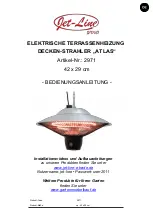
46
7.6 - Expansion
Tank
If an appliance is installed in a closed
water supply system, such as one
having a backflow preventer in the
cold water supply line, means shall be
provided to control thermal expansion.
Contact the water supplier or local
plumbing inspector on how to control
this situation.
Install an expansion tank. Ensure
the expansion tank is properly sized
for the water volume (See Section
17, header “Content of water”) and
the system volume, temperature and
pressure.
CAUTION!!!
Undersized
expansion tanks will cause
system water to be lost
through the relief valve.
The expansion tank must be located
as shown in Figure 7-5 or 7-6 or as
per recognized design methods. Refer
to the expansion tank manufacturer
instructions for additional installation
details.
7.7 - Sizing water
system
Size the pump, piping and system
components required in the water
system, using recognized design
methods.
CAUTION!!!
It is up to the
installer to ensure the minimum
flow is not less than the stated
on Section 7.2, at any time.
If the flow is lower, a scale
buildup will form inside the
heat exchanger, dramatically
reducing the life expectation
and voiding the warranty.
7.8 - Anti-legionella
This appliance is not protected
against the proliferation of the
Legionella bacteria. If you don’t
install any Anti-legionella external
system, you have to keep the water
temperature setpoint, at least at 140°F
(60°C). This temperature will prevent
the proliferation of the legionella
bacteria.
WARNING!!!
Your domestic
hot water system must be
protected against legionella
bacteria. Failure to comply with
this provision can result in
severe personal injury or death.
7.9 - Scalding
This appliance can deliver scalding
temperature water at any faucet in
the system. Be careful whenever
using hot water to avoid scalding
injury. Certain appliances such as
dishwashers and washing machines
may require increased temperature
water. By setting the water
temperature control on this appliance
to obtain the increased temperature
water required by these appliances,
you may create the potential for scald
injury.
To protect against injury, you should
install a mixing valve in the water
system.
This valve will reduce point of
discharge temperature by mixing cold
and hot water in branch supply lines.
Such valves are available from the
local plumbing supplier.
Figure 7-4 details the relationship
of water temperature and time with
regard to scald injury and may be
used as a guide in determining the
safest water temperature for your
applications.
APPROXIMATE TIME / TEMPERATURE
RELATIONSHIPS IN SCALDS
120°F (49°C)
More than 5 minutes
125°F (51°C)
1,5 to 2 minutes
130°F (54°C)
About 30 seconds
135°F (57°C)
About 10 seconds
140°F (60°C)
Less than 5 seconds
145°F (63°C)
Less than 3 seconds
150°F (65°C)
About 1,5 seconds
155°F (68°C)
About 1 second
Figure 7-4 - Time / temperature scalds
7 - INSTALLATION - Water connections
Summary of Contents for Infinite Energy2 IW1000
Page 3: ...3 SAFETY INSTRUCTIONS...
Page 5: ...5 SAFETY INSTRUCTIONS...
Page 122: ...122 16 MAINTENANCE...
Page 126: ...126 18 SPARE PARTS Spare parts...
Page 154: ...154 21 SEQUENCE OF OPERATION...
















































